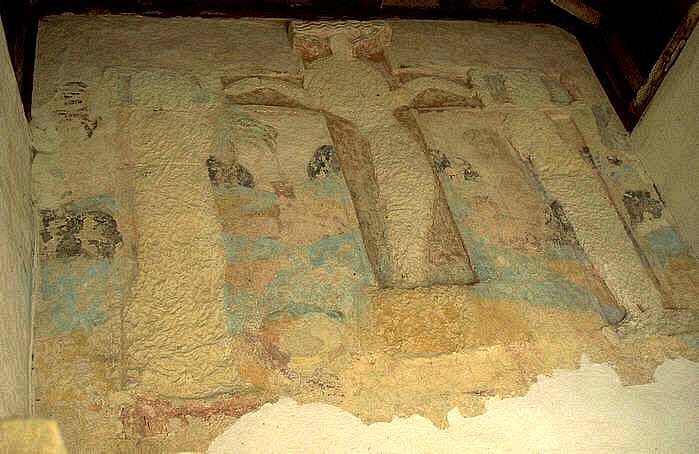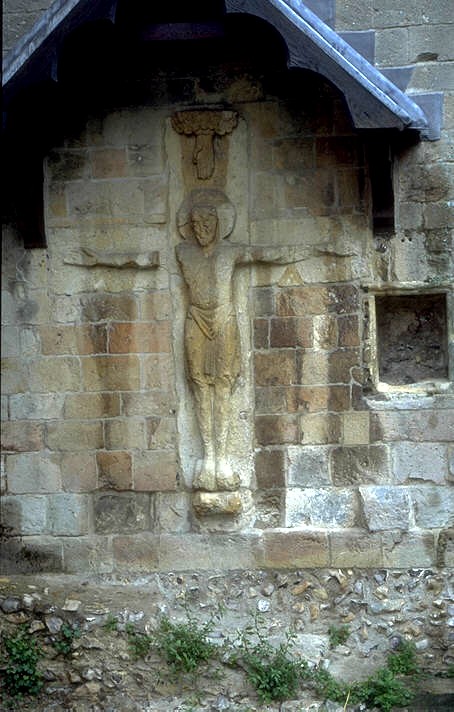Breamore, Hampshire (†Winchester) C.12?
Painted Rood

The survival of this once-painted low relief Rood and its painted background is the more astonishing because of its external situation. It is above the South Door in the porch covering the south doorway and thus open to the elements on one side. The lower part of the south porch was built around the middle of the 11th century, and there never seems to have been any doubt that the Rood itself is genuinely Saxon.
Certainly it is comparable in many aspects with the stone Rood (also on an external wall) at Headbourne Worthy in Hampshire, which also has the Manus Dei or Hand of God – seen here at Breamore reaching down from stylised clouds to indicate the crucified Son. The Headbourne example is believed to be 11th century and it is generally taken to be Saxon in all essentials even if it was carved after the Norman Conquest rather than before. Much the same has always been assumed about the Breamore Rood, so far as I can tell. But because it was so savagely mutilated after the Reformation, it is hard to be absolutely sure whether the swaying curve of Christ’s body is original to the carver. But if it is, then that in turn makes me slightly uneasy about the 11th century date.

Both the Headbourne Worthy Rood and the 11th century external Rood at Romsey Abbey share the older style articulation of the Crucifixion – Christ stands frontally on, rather than hangs from, the Cross, eyes open to signify his triumph over death, not his succumbing to it. His feet are fastened separately with two nails. This is exactly what we would expect of an English Saxon Rood, and the more typically ‘medieval’ type of Crucifixion, with slumped, clearly dead, body and human suffering stressed is generally said to have come in only at a later date.¹ In the 1330s Luke, Bishop of Tuy in Spain is writing in horror about the ‘novelties’ of the ‘heretics’ who make ‘images of our Lord with one foot laid over the other, so that both are pierced by a single nail’.² Several similar protests are on record.
Perhaps the graceful curve of Christ’s body is simply a distortion resulting from the mutilation of the Rood, but much as I would like the Breamore Rood to be the work of a Saxon carver, I feel obliged to record these doubts. The inclusion of the Manus Dei argues strongly for an early date, but the doubts remain, I think. I am certainly no expert on Saxon carving, though, and would be grateful for the opinion of anyone who is.
Whatever its date, the Rood was almost certainly painted originally, and the fragmentary remains of a painted background still exist It seems to have been a landscape, with (visible at one time) a church. On this point there seems to have been general agreement that the background was added later, but how much later is very difficult to say. The pale blue areas suggest use of a stable pigment such as massively expensive Ultramarine. The painting of the Suicide of Judas on the flanking west wall of the porch is probably contemporary with the background to the Rood – and the Suicide could easily be as late as the 15th century. About the remarkable Anglo-Saxon inscription in the church, though, there is no doubt – it is very early indeed.
Click here for the (later) Suicide of Judas flanking the Rood
Website for St Mary’s, Breamore
¹Perhaps not exclusively though. A wooden Cross with the crucified Christ in the ‘newer’ style was (perhaps still is) thought by many scholars to date from the second half of the 12th century. But John Beckwith plausibly suggests a date around 980 in Early Medieval Art, Thames & Hudson, 1964, pp.150-1.
²Quoted in GG Coulton, Medieval Panorama, Cambridge, 1949, p.567